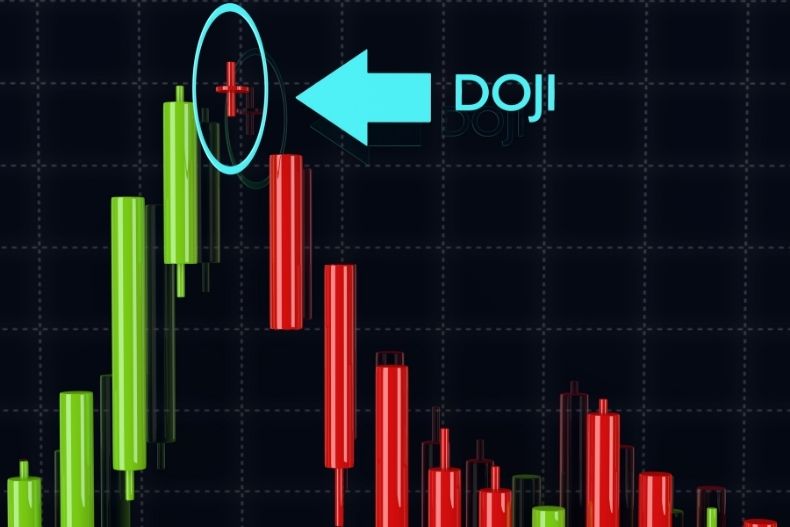The Doji candlestick, also known as the Doji star, is a special candle in the forex market that indicates indecision. Neither the bulls nor the bears have the upper hand. However, there are five different types of Doji candlesticks, and not all of them show indecision. That is why it is critical to comprehend how these candles shape and what this might mean for potential forex market price changes.
This article defines the Doji candlestick pattern and describes the five main varieties of Doji used in forex trading. It will also go through the best trading techniques for the Doji candlestick.

What Is the Doji Candlestick?
The Doji candlestick, also known as the Doji star, is distinguished by its ‘cross’ shape. This occurs when a forex pair opens and shuts at the same level, resulting in a minimal or non-existent body and equal-length upper and lower wicks. This occurs when a forex pair opens and shuts at the same level, resulting in a minimal or non-existent body and equal-length upper and lower wicks.
Advantages of Using the Doji Candlestick Pattern
The Doji star can be very useful because it gives forex traders a chance to “pause and reflect.” When the Doji pattern occurs in a trending market, it may be interpreted as a sign that buying momentum is slowing or selling momentum is beginning to pick up. Traders can interpret this as a signal to exit a long position.
This candle shape can, however, be considered per a technical predictor or your exit strategy. Traders can only exit those trades if the predictor or exit plan supports what the Doji is implying.
Remember that the stock may have been undecided for a short time before continuing to move in the direction of the pattern. As a result, a rigorous review is needed before leaving a position.
The Different Doji Candlesticks
Aside from the Doji candlestick mentioned earlier, there are four other Doji candlestick variants. While the standard Doji star denotes indecisiveness, the other variants will convey a different message, influencing traders’ policy and decisions.
Furthermore, the optimal Doji is very rare in the forex industry. Traders search for candles of different patterns which will almost always have a small body.
- Doji Star: It is ‘cross’ shaped, has the same opening and closing with the same, equal length upper and lower wick. It indicates indecision.
- Long-Legged Doji: It has an extended upper and lower wick and greater volatility. It indicates indecision.
- Dragonfly Doji: It appears at the bottom of a downtrend, shows the rejection of lower prices, and has a bullish signal. It indicates a change in the direction.
- Gravestone Doji: It appears at the top of an uptrend, shows the rejection of higher prices, and has a bearish signal. It indicates a change in direction.
- The 4 Price Doji: It is a horizontal line with high, low, open, and close, all at the same level. The Doji has a unique pattern signifying indecision and low volatility.
How to Trade the Doji Candlestick?
Ethical observers conclude that the price reflects all known facts about the stock, implying that the price is competitive. Even past market history has little bearing on potential price performance, and a stock’s current price can have little to do with its true or intrinsic value. As a result, technical traders use tools to sift through the noise to identify the best trades.
The candlestick map was created in the 18th century by a Japanese rice merchant called Honma from the town of Sakata, and it was brought to the West in the 1990s by Steve Nison.
There are four collections of data that help determine the form of a candlestick pattern. Analysts may make conclusions about price behavior based on this form. Every candlestick has an open, a high, a short, and a close. It makes no difference what time frame or tick interval is used. The body is the filled or hollow bar formed by the candlestick pattern. A hollow candlestick is formed when a stock closes higher than it opened. If the stock closes lower, the body of the candlestick would be filled. The Doji is one of the most popular candlestick formations.
When a stock’s open and close are almost identical, it forms a Doji, either singular or plural. From the standpoint of auction theory, Doji reflects indecision on the part of both buyers and sellers. Since everybody is evenly balanced, the price does not change; buyers and sellers are at odds.
Some observers have interpreted this as a symbol of turnaround. It may, however, be a period when buyers or sellers are gathering traction for a longer-term trend. Doji patterns are typical during times of restructuring and can help investors spot possible price breakouts.











